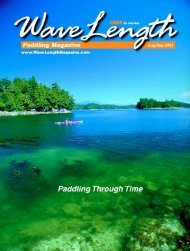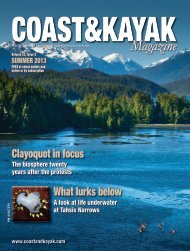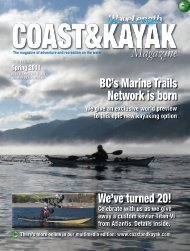Download - WaveLength Paddling Magazine
Download - WaveLength Paddling Magazine
Download - WaveLength Paddling Magazine
Create successful ePaper yourself
Turn your PDF publications into a flip-book with our unique Google optimized e-Paper software.
Know Your Neighbours<br />
Hidden Charms of Mangroves<br />
What does tropical paddling<br />
mean to you? Brochures invariably<br />
show white sandy beaches,<br />
shallow coral reefs and drooping coconut<br />
trees—our somewhat clichéd<br />
northern version of paradise. At an<br />
all-inclusive resort, that may well be<br />
all the tropical ecology you see. But<br />
if you do any real paddling down<br />
south, you’ll most likely find yourself<br />
in the forest.<br />
I’m not talking about river paddling<br />
mind you—I’m talking about<br />
mangroves, the only trees capable<br />
of living in salt water. Though they<br />
rarely make the brochures, mangrove<br />
forests make up a huge portion<br />
of many tropical shorelines,<br />
particularly in the shallow areas behind coral reefs that are popular<br />
with paddlers. Believe it or not, coconut palms are not even<br />
native to the Caribbean—the groves you find everywhere were originally<br />
planted, often after the native mangrove trees had been cleared<br />
and burnt.<br />
Do people love coconuts that much? Yes mon! And as you’ll<br />
quickly discover when you paddle up close, mangroves don’t have<br />
the same charm as swaying coconuts with white sand underneath.<br />
To put it mildly.<br />
Some first impressions? Instead of white sand, picture an impenetrable<br />
tangle of roots. How about some dark, sticky muck, or maybe<br />
even no visible land at all—just roots. Don’t forget bugs! Mosquitoes<br />
and biting midges might swarm you if there’s no breeze. And<br />
what’s that nasty, rotten eggs smell? Would you like to go “ashore”<br />
honey? Are you nuts? If the muck doesn’t swallow us whole, the<br />
crocodiles lurking in all those dark nooks and crannies might.<br />
But wait a minute. We’re paddlers, not cruise shippers. We’re<br />
captains of our own small, highly maneuverable boats, not grumpy<br />
passengers being ferried about by obsequious men in sailor suits.<br />
We know that some places, just like some people, need to be understood<br />
a bit better to be appreciated.<br />
So let’s talk about mangroves. To know them might not be to<br />
love them (unless you’re a geeky marine botanist), but you’ll find<br />
them far more interesting and appealing when you understand what<br />
makes them special.<br />
Shallow and sunlit red mangrove roots can be<br />
completely encrusted with animals and plants.<br />
Bryan Nichols photo<br />
Bryan Nichols<br />
WHAT ARE THEY<br />
Mangroves are trees that can deal<br />
with a combination of two things that<br />
would be deadly to every other<br />
tree—salt water and flooded roots.<br />
There are essentially only three species<br />
in most of the Caribbean, but<br />
there are many more in the (much<br />
older) Pacific. Mangroves aren’t necessarily<br />
closely related, and different<br />
species have different ways of dealing<br />
with salt and suffocation. We’ll<br />
use the Caribbean species as examples—they<br />
likely arrived around the<br />
time of the dinosaur’s demise, when<br />
Panama was open water and Pacific<br />
species could float through the gap.<br />
The most oceanic tree is the red<br />
mangrove (Rhizophora mangle). It can grow up from shallow salt<br />
water, blurring the line between land and sea. What looks like a<br />
forest from the air is actually more of a salt water swamp, a maze<br />
of channels and roots and short, scrubby trees. While that may not<br />
be appealing to Homo sapiens, these swamps are hugely important<br />
to a lot of other animals.<br />
WHY SO SPECIAL?<br />
First of all, they can be very productive. Though not too many<br />
things eat them directly, mangroves shed leaves and bark and other<br />
debris which drives an entire ecosystem of critters below. Besides<br />
just providing nutrients, this rich, convoluted region of roots becomes<br />
an ideal nursery for numerous species of fish and invertebrates,<br />
critters that grow up to become favorites on the reef—and<br />
in the restaurant.<br />
But mangrove forests aren’t just productive—they are protective<br />
as well. That maze of roots makes for the best line of defense against<br />
potential destruction from both directions. From the sea, hurricanes<br />
and cyclones would wreak far more havoc upon shorelines if much<br />
of their fury wasn’t buffered by mangroves. This becomes painfully<br />
(and expensively) obvious to resorts and cities that clear all their<br />
mangroves and then get hit by one of those increasingly frequent<br />
storms.<br />
And it works both ways—floods of freshwater, silt and pollution ➞<br />
October/November 2002 www.<strong>WaveLength</strong><strong>Magazine</strong>.com<br />
21
















